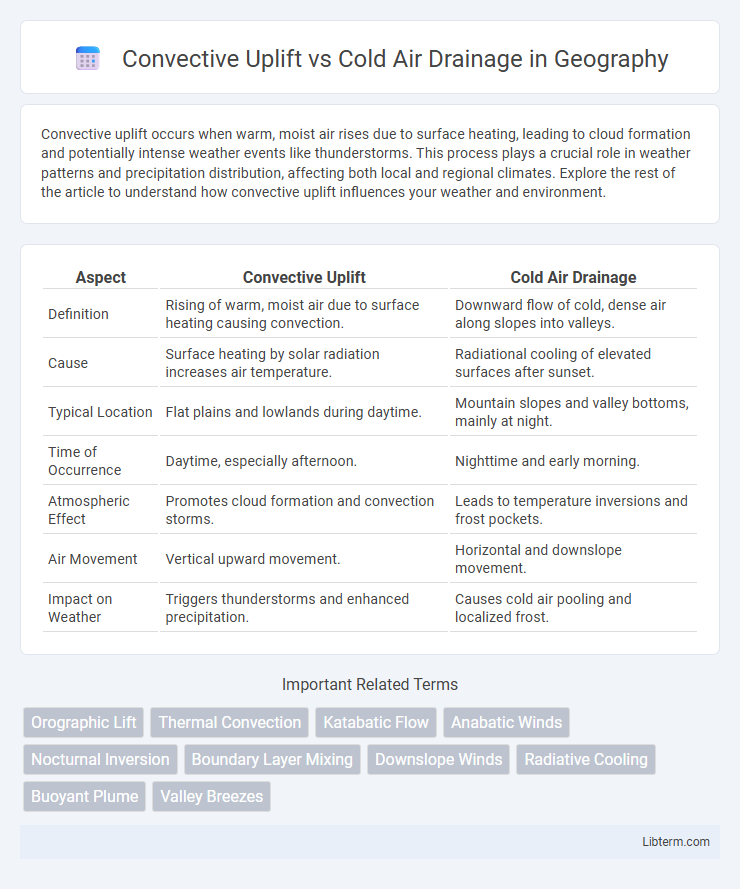Convective uplift occurs when warm, moist air rises due to surface heating, leading to cloud formation and potentially intense weather events like thunderstorms. This process plays a crucial role in weather patterns and precipitation distribution, affecting both local and regional climates. Explore the rest of the article to understand how convective uplift influences your weather and environment.
Table of Comparison
| Aspect | Convective Uplift | Cold Air Drainage |
|---|---|---|
| Definition | Rising of warm, moist air due to surface heating causing convection. | Downward flow of cold, dense air along slopes into valleys. |
| Cause | Surface heating by solar radiation increases air temperature. | Radiational cooling of elevated surfaces after sunset. |
| Typical Location | Flat plains and lowlands during daytime. | Mountain slopes and valley bottoms, mainly at night. |
| Time of Occurrence | Daytime, especially afternoon. | Nighttime and early morning. |
| Atmospheric Effect | Promotes cloud formation and convection storms. | Leads to temperature inversions and frost pockets. |
| Air Movement | Vertical upward movement. | Horizontal and downslope movement. |
| Impact on Weather | Triggers thunderstorms and enhanced precipitation. | Causes cold air pooling and localized frost. |
Introduction to Atmospheric Vertical Motions
Convective uplift occurs when warm air rises due to surface heating, creating vertical motion essential for cloud formation and precipitation. Cold air drainage involves the downward movement of cooler, denser air along slopes, impacting local weather by stabilizing the atmosphere and reducing vertical mixing. Understanding these contrasting vertical motions is crucial for predicting weather patterns and microclimate variations.
Understanding Convective Uplift
Convective uplift occurs when warm air near the Earth's surface rises due to lower density, forming clouds and precipitation as it cools at higher altitudes. This vertical movement is driven by solar heating and surface temperature gradients, influencing weather patterns and severe storm development. Understanding convective uplift is critical for predicting thunderstorm formation and local climatic variations.
Fundamentals of Cold Air Drainage
Cold air drainage occurs when denser, cooler air flows downslope into lower elevation areas due to gravity, typically during nighttime or clear-sky conditions. This process leads to temperature inversions and localized frost pockets, significantly affecting microclimates and agricultural practices. Understanding the fundamental mechanism of cold air pooling is essential for predicting frost hazards and optimizing land use in valleys and basins.
Key Differences Between Convective Uplift and Cold Air Drainage
Convective uplift occurs when warm air rises due to surface heating, leading to cloud formation and potential precipitation, while cold air drainage involves the movement of denser, cooler air downslope into valleys. Key differences include the direction and driving forces: convective uplift is driven by thermal buoyancy causing upward motion, whereas cold air drainage is driven by gravity causing downslope flow. Convective uplift typically promotes vertical air movement and weather events at higher altitudes, whereas cold air drainage influences surface temperature inversions and frost formation in low-lying areas.
Meteorological Conditions Favoring Convective Uplift
Convective uplift occurs when surface heating causes warm air to rise, creating strong vertical motion often favored by clear skies, intense solar radiation, and unstable atmospheric conditions with a steep lapse rate. These meteorological parameters enhance buoyancy, facilitating the development of towering cumulus clouds and potentially thunderstorms. In contrast, cold air drainage requires calm nights and radiative cooling over sloped terrain, conditions generally inhibiting convective uplift.
Typical Environments for Cold Air Drainage
Cold air drainage typically occurs in valleys, basins, and gentle slopes where denser cold air flows downslope under the influence of gravity, especially during clear nights with calm winds. These environments often experience temperature inversions, leading to frost pockets and localized cooling effects important for agriculture and frost management. Unlike convective uplift, which dominates in hilly or mountainous regions with strong daytime heating, cold air drainage is characteristic of calm, stable atmospheric conditions.
Impacts on Local Weather and Climate
Convective uplift drives localized thunderstorms and intense precipitation by causing warm, moist air to rise rapidly, significantly influencing temperature and humidity patterns in affected regions. Cold air drainage occurs when denser, cooler air flows downhill into valleys, leading to temperature inversions and frost pockets that impact microclimates by maintaining cooler nighttime temperatures. Both processes alter local atmospheric stability and moisture distribution, shaping daily weather variability and long-term climatic conditions in mountainous and valley environments.
Influence on Air Quality and Pollution Dispersion
Convective uplift enhances vertical mixing of air pollutants, leading to improved dispersion and reduced surface-level pollutant concentrations, especially in urban environments with significant solar heating. Cold air drainage causes dense, cool air to flow downslope and accumulate in valleys or low-lying areas, resulting in pollutant trapping and localized increases in air pollution concentrations. Understanding the interplay between convective uplift and cold air drainage is critical for urban planners and environmental scientists to accurately predict air quality patterns and mitigate pollution exposure risks.
Effects on Agriculture and Natural Ecosystems
Convective uplift enhances vertical air movement, promoting cloud formation and precipitation that benefit crop irrigation and natural vegetation growth, leading to increased soil moisture and nutrient cycling. Cold air drainage, characterized by the slow flow of cooler, denser air into valleys during nighttime, can create frost pockets that damage sensitive crops and stress cold-intolerant ecosystems. Understanding these atmospheric processes aids in optimizing agricultural practices and ecosystem management by mitigating frost risk and enhancing water availability.
Summary and Future Research Directions
Convective uplift drives atmospheric motion by transporting warm, moist air upward, significantly impacting local weather and climate patterns, while cold air drainage involves the downslope flow of dense, cool air that shapes microclimates and influences frost risks. Future research should prioritize high-resolution modeling to capture small-scale interactions between these processes and their roles in extreme weather events and climate change adaptation strategies. Integrating remote sensing data with ground-based observations will enhance understanding of spatial and temporal variability, improving predictive capabilities.
Convective Uplift Infographic

 libterm.com
libterm.com